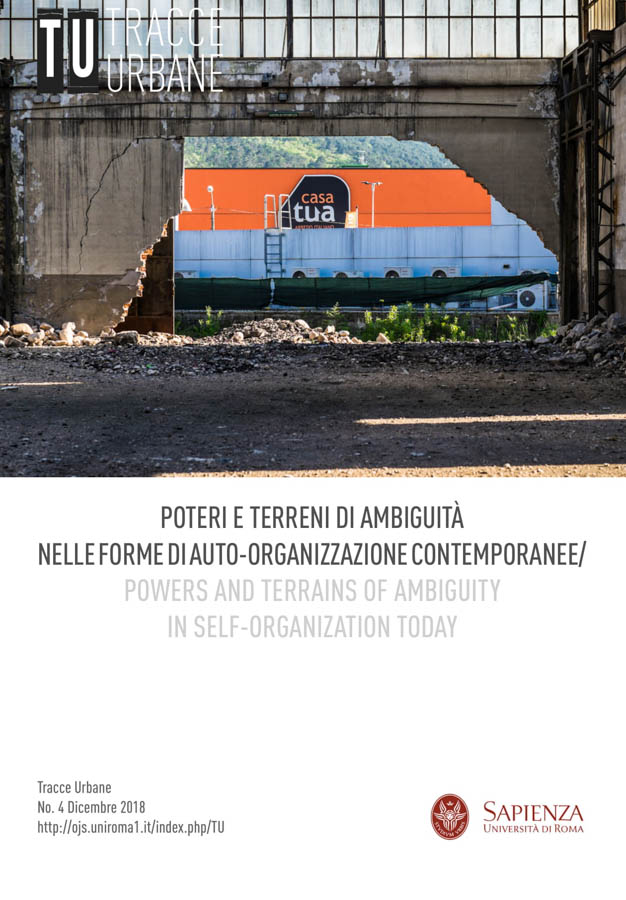Public purpose in temporary self-organization practices: Lessons from Santiago’s Mapocho Pedaleable practice
DOI:
https://doi.org/10.13133/2532-6562_2.4.14391Abstract
This paper examines the relation between self-organization and State institutions through the study of Santiago’s Mapocho Pedaleable practice; a reclamation of an unused river bed in the city as a space for the public. Centering in the discussion of the public sphere, the paper critically explores the extent to which self-organization practices challenge the meaning of the public when creating spaces in which citizens come together, with a common purpose, in an intent to compel authorities to action. By questioning the relationship between civic organizations and State institutions, the research seeks to unravel the extent to which the different actors involved pursue public purpose through self-organization practices. I suggest that the transformative potential of self-organized practices can only be expanded when public purpose predominate over private interests at stake. A qualitative research approach was adopted to conduct this exploratory study, based primarily on semi-structured interviews conducted in the field that are part of a wider research endeavor.
References
Arendt, H. (2013). The Human Condition. Chicago: University of Chicago Press.
Bodnar, J. (2015). Reclaiming Public Space. Urban Studies, 52(12), 2090–2104.
de Certau, M. (1984). The Practice of Everyday Life, Volume 1. Berkley, Los Angeles, London: University of California Press.
De Magalhães, C. (2010). Public Space and the Contracting-out of Publicness: A framework for analysis. Journal of Urban Design, 15(4), 559-574.
Ferreri, M. (2015). The Seductions of Temporary Urbanism. ephemera, 15(1), 181.
Fraser, N. (1990). Rethinking the Public Sphere: A contribution to the critique of actually existing democracy. Social text(25/26), 56-80.
Gadanho, P. (2014). Uneven Growth: Tactical urbanisms for expanding megacities. In R. Burdett, T. Cruz, & D. Harvey (Eds.). New York: The Museum of Modern Art.
Goodnight, G. T. (1997a). Opening Up ''The Spaces of Public Dissension''. Communication monographs, 64(3), 270-275.
Goodnight, G. T. (1997b). Studies in the Public Sphere. The Quarterly journal of speech, 83(3), 351-370.
Goodnight, G. T. (2012). The Personal, Technical, and Public Spheres of Argument: A speculative inquiry into the art of public deliberation. Argumentation and Advocacy, 48(4), 198-210.
GORE. (2017). Inauguran segunda versión del Ciclopaseo “Mapocho Pedaleable” provisorio. Retrieved from https://www.gobiernosantiago.cl/inauguran-segunda-version-del-ciclopaseo-mapocho-pedaleable-provisorio
Habermas, J. (1989). The Structural Transformation of the Public Sphere, trans. Thomas Burger. Cambridge: MIT Press, 85, 85-92.
Habermas, J., Lennox, S., & Lennox, F. (1974). The Public Sphere: An encyclopedia article New German Critique(3), 49-55.
Harper, D. (2001-2017). Online Etymology Dictionary. Retrieved from http://www.etymonline.com/
Hauser, G. A. (1998). Civil Society and the Principle of the Public Sphere. Philosophy & rhetoric, 31(1), 19-40.
Hauser, G. A. (2001). On Reading and Misreading the Rhetoric of Publics and Public Spheres. Argumentation and Advocacy, 37(4), 217-217.
Hidalgo, R., & Janoschka, M. (2014). La Ciudad Neoliberal: Gentrificación y exclusión en Santiago de Chile. (R. Hidalgo & M. Janoschka Eds.). Buenos Aires, Ciudad de México y Madrid: Pontificia Universidad Católica de Chile.
Hou, J. (2010). Insurgent Public Space: Guerrilla urbanism and the remaking of contemporary cities. London: Routledge.
Lopez‐Morales, E. (2011). Gentrification by Ground Rent Dispossession: The shadows cast by large‐scale urban renewal in Santiago de Chile. International Journal of Urban and Regional Research, 35(2), 330-357.
Low, S., & Smith, N. (2006). The Politics of Public Space. New York: Routledge.
Lydon, M., & Garcia, A. (2015). Tactical Urbanism: Short-term action for long-term change. In. Washington: Island Press.
Madanipour, A. (2017). Cities in Time: Temporary urbanism and the future of the city. London and New York: Bloomsbury Publishing.
Pedaleable. (2017). Yo Vivo Mapocho Pedaleable. Un evento ciudadano. Retrieved from http://www.pedaleable.org/yo-vivo-mapocho/
Phillips, K. R. (1996). The Spaces of Public Dissension: Reconsidering the public sphere. Communications Monographs, 63(3), 231-248.
Rendell, J. (2008). Critical Spatial Practice. Retrieved from http://www.janerendell.co.uk/wp-content/uploads/2009/06/critical-spatial-practice.pdf
Rosa, M. L., & Weiland, U. E. (2013). Handmade Urbanism: From community initiatives to participatory models. Berlin: Jovis Verlag.
Staiger, U. (2009). Cities, Citizenship, Contested Cultures: Berlin's Palace of the Republic and the politics of the public sphere. cultural geographies, 16(3), 309-327.
Taylor, M. (2006). From Pinochet to the 'Third Way': Neoliberalism and social transformation in Chile. London: Pluto Press
Villa, D. R. (1992). Postmodernism and the Public Sphere. American Political Science Review, 86(03), 712-721.
Watson, S. (2006). City publics: The (dis) enchantments of urban encounters: Psychology Press.
Downloads
Published
How to Cite
Issue
Section
License
NOTA DI COPYRIGHT
Proposta di licenza Creative Commons
1. Proposta per riviste Open Access
Gli autori che pubblicano su questa rivista accettano le seguenti condizioni:
Gli autori mantengono i diritti sulla loro opera e cedono alla rivista il diritto di prima pubblicazione dell'opera, contemporaneamente licenziata sotto una Licenza Creative Commons - Attribuzione che permette ad altri di condividere l'opera indicando la paternità intellettuale e la prima pubblicazione su questa rivista.
Gli autori possono aderire ad altri accordi di licenza non esclusiva per la distribuzione della versione dell'opera pubblicata (es. depositarla in un archivio istituzionale o pubblicarla in una monografia), a patto di indicare che la prima pubblicazione è avvenuta su questa rivista.
Gli autori possono diffondere la loro opera online (es. in repository istituzionali o nel loro sito web) prima e durante il processo di submission, poiché può portare a scambi produttivi e aumentare le citazioni dell'opera pubblicata (Vedi The Effect of Open Access).


